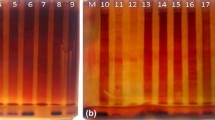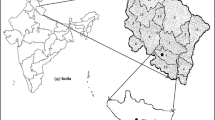Abstract
Five cultivated forms and one wild accession of Lily of the Valley, Convallaria majalis L., have been investigated to estimate their genetic diversity and their genetic distances. Five enzyme systems were studied: esterase, acid phosphatase, peroxydase, phosphoglucomutase and superoxyde dismutase. Esterase system gave the lowest polymorphism, peroxydase and phosphoglucomutase systems gave the highest polymorphism. Grandiflora of Nantes, German and Fortunea Lily of the Valley appeared to be genetically different. In addition the Fortunea type which is a tetraploid form does not result in a polyploidization of any diploid types studied in this report. These cultivated forms could be the result of a natural and/or directed selection from wild Lily of the Valley.
Similar content being viewed by others
Abbreviations
- EST-:
-
Esterase
- AP-:
-
Acid phosphatase
- PGM-:
-
Phosphoglucomutase
- PER-:
-
Peroxydase
- SOD-:
-
Superoxyde dismutase
References
Anonymous, 1973. Le Muguet. Note technique C.N.I.H., Tec 02, 42 pp.
Bradford, M., 1976. A rapid and sensitive method for the quantitation of microgram quantities of proteins utilizing the principle of protein-dye binding. Anal. Biochem. 72: 248–254.
Dalgren, R.M.T., H.T. Clifford & P.F. Yeo, 1985. The families of the monocotyledons. Springer Verlag, Berlin, pp. 137–140.
Hebert, Y. & P. Vincourt, 1985. Mesure de la divergence génétique. In: M. Lefort-Buson & D. De Vienne (Eds.), Les Distances Génétiques, Estimations et Applications, pp. 23–27. INRA Pub.
Le Nard, M. & P. Verron, 1993. Convallaria majalis L. In: A.A. De Hertog & M. Le Nard (Eds.) The Physiology of Flower Bulbs, pp. 249–256, Elsevier, Amsterdam.
Reimann-Philipp, R., 1956. Die Erzeugung polyploïder Formen von Convallaria majalis sowie einige Beobachtungen über die Wirkung der Maiblumen Glykoside auf die Mitose. Zeitschrift für Pflanzenzüchtung 36: 289–304.
Reimann-Philipp, R., 1986. 35 Jahre Züchtungsarbeit bei Maiblumen Erfahrungen und Ergebnisse. Deutscher Gartenbau 32: 1458–1459.
Reimann-Philipp, R., 1987. Convallaria majalis (Lily of the Valley) improved as an ornamental plant after 35 years of breeding work. Acta Horticulturae 205: 65–69.
Streveler, B., 1966. A taxonomic study of the genus Convallaria (Liliaceae). Thesis, University of Wisconsin, Madison, 89 pp.
Utech, F.H. & S. Kawano, 1976. Floral vascular anatomy of Convallaria majalis L. and Convallaria keiskei Miq., (Liliaceae-Convallariinae). Bot. Mag. Tokyo 89: 173–182.
Vallejos, C.E., 1983. Enzyme activity staining. In: S.D. Tanksley & T.J. Orton (Eds), Isozymes in Plant Genetics and Breeding, part A, pp. 469–516. Elsevier, Amsterdam.
Vilmorin-Andrieux, S.A., 1939. Les fleurs de pleine terre. Librairie des Sciences et des Arts, Paris, pp. 703–704.
Wetter, L. & J. Dyck, 1983. Isoenzyme analysis of cultured cells and somatic hybrids. In: D.A. Evans, W.R. Sharp, P.V. Ammirato & Y. Yamada (Eds.), Handbook of Plant Cell Culture, Vol. 1, Techniques for Propagation and Breeding, pp. 607–628. Mac Millan Pub., New York.
Author information
Authors and Affiliations
Rights and permissions
About this article
Cite this article
Verron, P., Le Nard, M. Characterization of five improved varieties and one wild accession of Lily of the Valley (Convallaria majalis L.) by isozyme analysis and assessment of genetic distances. Euphytica 70, 21–26 (1993). https://doi.org/10.1007/BF00029636
Received:
Accepted:
Issue Date:
DOI: https://doi.org/10.1007/BF00029636




